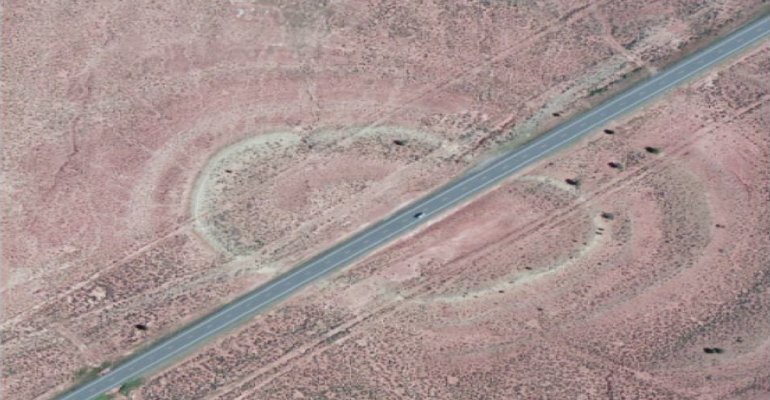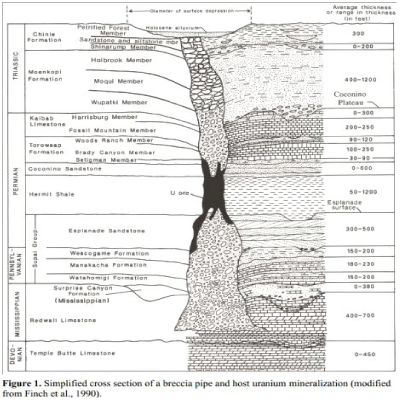
Breccia pipes are vertical collapse structures, typically a few tens to hundreds of feet across and hundreds to thousands of feet in vertical extent. The pipes formed more than 200 million years ago within Paleozoic and Triassic rocks over a broad area of the Colorado Plateau around the Grand Canyon. The pipes formed as groundwater, flowing through the Redwall Limestone, dissolved material along fracture zones and created caves. Continued dissolution caused collapse of overlying rocks into the caves forming breccia pipes and sink holes.
 The Arizona Geological Survey has just completed and made available a new report “Partial database for breccia pipes and collapse features on the Colorado Plateau, northwestern Arizona” which you can download here. The cover of the report shows Highway 89 crossing a depression, the surface expression of a breccia pipe.
The Arizona Geological Survey has just completed and made available a new report “Partial database for breccia pipes and collapse features on the Colorado Plateau, northwestern Arizona” which you can download here. The cover of the report shows Highway 89 crossing a depression, the surface expression of a breccia pipe.
The Survey has identified “1300 pipes or suspected pipes” in the region. “Mineralized breccia pipes—pipe-like masses of broken rock—may contain high-grade uranium ore and variable amounts of copper, gold, silver, vanadium and other mineral ore. More than 71 mineralized breccia pipes have been discovered in the region, and as of 2010, nine of these pipes yielded more than 10,500 metric tons of uranium.” “It appears from this work that the number of suspected breccia pipes is one to two orders of magnitude greater than previously recognized. (The number may be even higher since many pipes do not yet have a surface expression.) The study raises the possibility that the higher concentration of breccia pipes is likely to extend across the entire region.” This means also that there is potential for much more uranium and other valuable minerals.
The breccia pipes exist because of the nature of the Redwall Limestone, a 350-million-year old formation that forms high red cliffs near the bottom of the Grand Canyon. The limestone is actually grey, but has been stained by iron and manganese oxides derived from overlying formations.
The Arizona Geological Survey has another publication on the history of the Redwall Limestone itself. You can download it here. That publication is non-technical, has many illustrations and is suitable for the layman or classroom.
Among the properties of the Redwall Limestone are:
- Diverse and long history over the last 350 million years.
- Magnificent cliffs and red walls.
- Composed of ~99.5% pure limestone, ~95% of which is biologically formed in the presence of organisms.
- Forms very chemically-resistant cliffs, yet it is a very soft rock (slightly harder than a finger nail).
- Has thousands of miles of interconnected caverns spread out over the Colorado Plateau.
- Has many caverns, some with ancient and modern speleothems.
- Is the source of carbonate for the growth of abundant travertine deposits.
- Provides precious minerals, trace metals and uranium in breccia pipes
- Is a major source of high-quality groundwater to numerous and voluminous springs in the canyon and region, consumed by most visitors to the canyon.
- “Living in the Past” implies the past of the Redwall Limestone is living with us today
 Although the area holds great potential for mineral resources which could be mined with minimal disturbance to the environment, radical greens and their Congressional fellow travelers are bent on banning mining in the area.
Although the area holds great potential for mineral resources which could be mined with minimal disturbance to the environment, radical greens and their Congressional fellow travelers are bent on banning mining in the area.
On January 9, 2012, the Obama administration announced a 20-year ban on new mining claims on public land near Grand Canyon National Park, thereby denying access to valuable minerals resources. Now there is a proposal to establish “Grand Canyon Watershed National Monument” which would cover 1.7 million additional acres (see green areas on the map here). If established, then all mineral potential of the area would be off limits. See details of current and pending areas made off-limits to mineral production here.
See also:
Uranium mining ban near Grand Canyon all politics, no science
